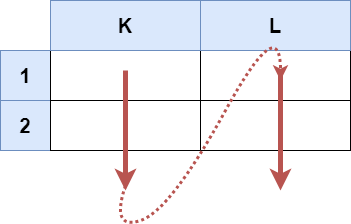LeetCode-in-Java
2194. Cells in a Range on an Excel Sheet
Easy
A cell (r, c) of an excel sheet is represented as a string "<col><row>" where:
<col>denotes the column numbercof the cell. It is represented by alphabetical letters.- For example, the
1stcolumn is denoted by'A', the2ndby'B', the3rdby'C', and so on.
- For example, the
<row>is the row numberrof the cell. Therthrow is represented by the integerr.
You are given a string s in the format "<col1><row1>:<col2><row2>", where <col1> represents the column c1, <row1> represents the row r1, <col2> represents the column c2, and <row2> represents the row r2, such that r1 <= r2 and c1 <= c2.
Return the list of cells (x, y) such that r1 <= x <= r2 and c1 <= y <= c2. The cells should be represented as strings in the format mentioned above and be sorted in non-decreasing order first by columns and then by rows.
Example 1:

Input: s = “K1:L2”
Output: [“K1”,”K2”,”L1”,”L2”]
Explanation:
The above diagram shows the cells which should be present in the list.
The red arrows denote the order in which the cells should be presented.
Example 2:

Input: s = “A1:F1”
Output: [“A1”,”B1”,”C1”,”D1”,”E1”,”F1”]
Explanation:
The above diagram shows the cells which should be present in the list.
The red arrow denotes the order in which the cells should be presented.
Constraints:
s.length == 5'A' <= s[0] <= s[3] <= 'Z''1' <= s[1] <= s[4] <= '9'sconsists of uppercase English letters, digits and':'.
Solution
import java.util.ArrayList;
import java.util.List;
public class Solution {
public List<String> cellsInRange(String str) {
char[] c = str.toCharArray();
List<String> strings = new ArrayList<>();
for (char i = c[0]; i <= c[3]; i++) {
for (char j = c[1]; j <= c[4]; j++) {
strings.add(new String(new char[] {i, j}));
}
}
return strings;
}
}

